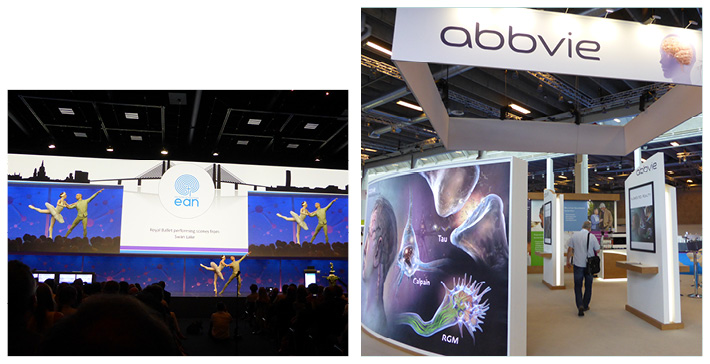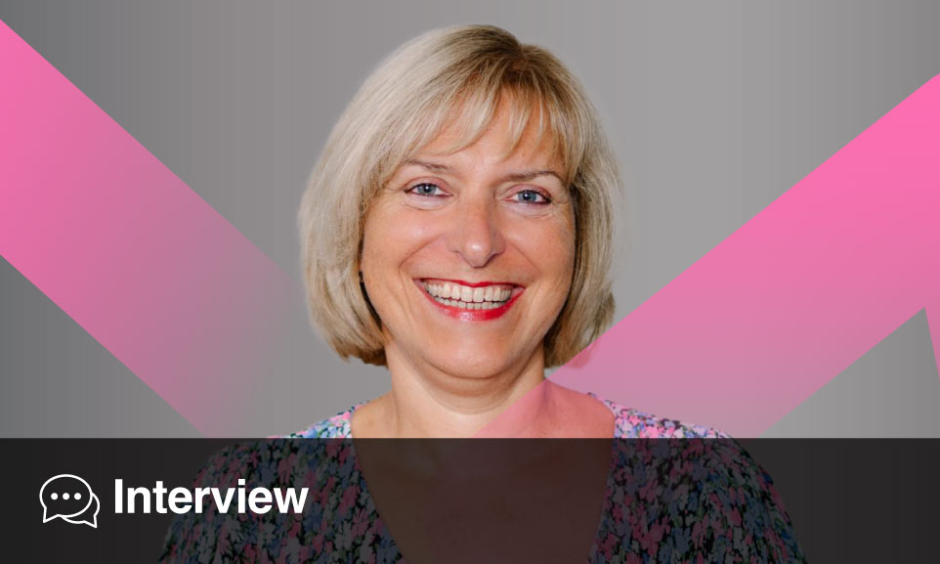Although history and tradition are hallmarks of Danish culture, recent developments have created a hub of modern Danish trademarks in Copenhagen. Hosted jointly by the European Academy of Neurology (EAN) and the Danish Neurological Society (DNS), the 2nd EAN congress joins the throng of innovative events and projects growing in Ørestad, the rising neighbourhood of Copenhagen. Prof Mads Ravnborg, President of the DNS, perfectly summarised the nature of EAN 2016 in his opening address: “Our purpose is international networking, free exchange of knowledge, mutual understanding, and friendship across national borders and cultures.”
A young society no less steeped in tradition than any other, the EAN, with its 47 member societies and 25,000 members, is perfectly situated to offer a platform for multidisciplinary collaboration and debate. This year’s congress welcomed almost 6,000 neurologists to share in a combination of scientific and educational excellence, with plenty of opportunity for discussion of research, resource allocation, and healthcare policy, all of which are advocated by the EAN for the benefit of all European healthcare professionals with an interest in neurology.
Alongside oral sessions, poster presentations, and practical tutorials, the congress presented a variety of awards acknowledging the high quality of research emerging in the realm of neurology. Prizes included the Investigator’s Award, given to the 20 best presentations across the congress, and the P.K. Thomas Prize, awarded to the best paper on peripheral nerve disorders. In two sessions, 12 young researchers presented their work in competition for the EAN 2016 Tournament prizes. Asya Ekmen, France, went home with first prize in the basic neurology category, for the presentation of ‘Zinc release and action at excitatory Schaeffer collateral-CA1 pyramidal cell synapses’.
With regard to clinical neurology, Marte Helene Bjørk, Norway, won the day with a paper entitled ‘Low maternal folic acid in women with epilepsy during pregnancy is linked to autistic traits in the child at 3 years of age.’ Both of these sessions also awarded two runners up. For clinical neurology, Hans-Georg Wirsching, Switzerland, was awarded for a study of complete glioblastoma resection, while Simão Cruz, Portugal, was acknowledged for research concerning clinical, biochemical, molecular, and histological features of mitochondrial disorders. In the basic neurology category, Marta Pace, Switzerland, came runner up for investigation of sleep deprivation in pre-ischaemia preconditioning, alongside Tobi van Den Bossche, Belgium, for characterisation of Alzheimer’s disease patients with the SORL1 genetic mutation.
There was a massive amount of research on display at the event, captivating the rapid rate of progress that has been observed in the field of neurology in recent times. Presentations at EAN displayed research that is certain to increase understanding of conditions such as dementia, Alzheimer’s disease, Parkinson’s disease, and stroke, amongst many others. There is no doubt that there are many challenges ahead for neurologists in Europe in the years ahead, with certain types of neurological conditions increasing in prevalence, particularly in the context of an ageing population. As such, a lot of presentations at the EAN congress outlined the need for new strategies to cope with, and tackle the increasing demand for care.
In the following review, we bring you breaking news direct from EAN 2016, providing a snapshot of activity at the frontiers of neurological research. We hope you find the stories insightful and fruitful to your own practice. We await another year of neurological progress and the 2017 EAN congress in Amsterdam, Netherlands.

Cultivating a New Paradigm of Stroke Care
SIGNIFICANT developments in stroke care have been seen in recent years and many trials were presented at EAN 2016 looking at specialist centres, imaging options, and treatment for stroke patients, aiming to confirm the effectiveness of these new options. The highlights were reported in a EAN press release dated 30th May 2016. Prof Franz Fazekas, Department of Neurology, Medical University of Graz, Graz, Austria, discussed the need for a change in processes for these new developments to be effectively implemented, saying: “This reorganisation must cover the entire chain of care, from the ambulance ride to the precisely defined use of thrombectomies.”
Thrombectomy has been hailed as a novel treatment option in many recent trials, with >60% of patients now surviving a stroke with little or no impairment following the procedure. European organisations have now come together with the aim of providing a treatment consensus paper, defining all aspects of thrombectomy, from when to use it, to what instruments to use, and how to care for the patient postoperatively. Prof Fazekas suggested that many lives will be saved or improved with the implementation of these guidelines.
Specialised centres for stroke care have been rising recently, providing more specialist staff with more up-to-date knowledge that was hoped to revolutionise care. A recent study of 9,500 patients from the Danish stroke registry has shown that since the change to specialist centres, more patients are receiving thrombolysis within an hour of reaching hospital, more patients are receiving early procedures to treat carotid artery stenosis, and 30-day mortality is reducing. These benefits echo the initial intentions of these centres and give a positive outlook for future improvements in care.
Making the correct decision when treating a stroke is essential and imaging is a key part of the diagnosis, thus confidence in the image presented is vital to choosing the right care in the right time. A recent study of 444 patients showed that doctors are now more confident in magnetic resonance imaging and provide better decisions despite the increased imaging time.
Virtual Support may have Three-Fold Benefit for Epilepsy Patients
COMMUNICATION could be key to bettering the lives of epilepsy patients, suggests a EAN press release dated 29th May 2016. Patients with a variety of chronic diseases have demonstrated great improvements through the use of support networks, however for patients with epilepsy such groups are unfortunately hard to come by. “Networking and mutual support through instant messaging services such as WhatsApp can be a practical and affordable alternative in these cases,” highlighted Dr Heather Angus-Leppan, Consultant Neurologist, Royal Free Hospital, London, UK.
With this observation in mind, a group of researchers are investigating the possible outcomes of a virtual discussion group designed to promote mutual support between epilepsy patients. Using the online service WhatsApp to create an instant messaging group, the team created a discussion forum connecting 300 epilepsy patients; this group continued beyond the initial research. Contribution is at the discretion of each individual participant, and important issues such as navigating stigmatism in the workplace are open for conversation. The study aims to examine the effect of the virtual facilitation of communication over a period of 6 weeks.
The study aims to explore the possible benefits that instant messaging groups and the involvement each patient has in them have on three different parameters of patient healthcare: adherence to therapy, length of hospital stay, and quality of life. Moreover, the team are also interested in the notion that increased involvement in the support group and further interpersonal contact may influence the results within these parameters. Dr Angus-Leppan has high hopes for the data: “Based on current findings, we expect to see intensive personal communication improve the patient’s adherence to therapy by 20%, lower the frequency of their stays in the hospital, and improve their quality of life by 10%.” The conclusion of this study will illuminate the potential of virtual support groups for patient healthcare.

Neurological Expertise will be Vital to Battling Zika Epidemic
“EUROPE certainly needs to get prepared, just as other parts of the world, to cope with the consequences of the fact that the geographical distribution of the [Zika] virus is steadily and rapidly expanding” were the sombre words of Prof John England, Louisiana State University, New Orleans, Louisiana, USA, reported in a EAN press release dated 30th May 2016.
Indeed, with 60 countries and territories reporting mosquito-born Zika virus, as well as 10 countries, including Germany and France, reporting person-to-person transmission, the need for formal guidelines is pertinent. Despite lower risk in Europe than other continents, imported cases have already begun to emerge, including a case of Guillain–Barré syndrome (GBS) in the Netherlands. The association of fetal deformations such as microcephaly with the virus is well known amongst the general public, however awareness of the neurological risks for infected patients is low, and the true extent of possible cognitive complications is currently indefinable. “Neurological expertise will be crucial to deal with the consequences of Zika,” emphasised Prof Ra’ad Shakir, President of the World Federation of Neurology (WFN).
According to the World Health Organization (WHO), Europe is at a low-to-moderate risk of the mosquito-born Zika virus infection, with the exception of regions populated with the Aedes aegypti mosquito. Nonetheless, the epidemic is expected to grow in Europe as a result of person-to-person transmission and travel. “All European countries should put measures in place in order to detect imported cases of Zika virus early and should provide public health advice to travellers to and from affected countries,” advised Prof England.
As there are expected to be a high number of travellers to Rio de Janeiro for the 2016 Olympics, this advice is particularly significant as there are currently no particular treatment strategies or vaccines. The WHO and the Pan American Health Organization (PAHO) suggest the use of insect repellent, appropriate clothing, safe sex or abstinence, and air-conditioned accommodation where possible.
Call for European Guidelines to Tackle Alzheimer’s Disease
AN APPEAL has been issued for standardised European guidelines for the treatment of Alzheimer’s disease and approaches to its early identification in response to concerns for both safety and unsatisfactory care, stated a EAN press release dated 30th May 2016.
Prof Gunhild Waldemar, Neuroscience Centre, Rigshospitalet, University of Copenhagen, Copenhagen, Denmark, has called for researchers to work together and draw up guidelines towards effective treatments for Alzheimer’s disease, the most common form of dementia. The future human and economic costs of this condition make such a strategy all the more necessary, with experts predicting the number of cases worldwide to rise from 47 million in 2015 to 75 million by 2030.
A better understanding of the condition is thought to be needed alongside more effective treatments and accurate early identification. As a result, Prof Waldemar warns against the assumption that Alzheimer’s disease is an inevitability of old age. Modern imaging technology, biomarkers in the blood or spinal fluid, and genetic testing can all be used to support prognoses or early diagnosis of Alzheimer’s disease, but it must be remembered that misinterpretation of such tests can have devastating effects. “In future we will need medical, ethical, and legal guidelines to determine what form these tests should take, when they are appropriate, and to guide pre-biomarker counselling in patients,” proposed Prof Waldemar.
The quality and suitability of care provided for dementia patients has also been criticised by Prof Waldemar, who calls for evidence-based guidelines for pharmacological treatment and more training for everyone involved in primary healthcare. A Danish study presented at the EAN congress revealed the unregulated doses and combinations of antipsychotic and other psychotropic medicines being prescribed for Alzheimer’s patients despite a lack of evidence on their effectiveness.
Additionally, a Swedish study presented evidence of insufficient medical treatment in response to other health problems faced by dementia patients. The research revealed the decreased probability of a patient receiving the drug warfarin to treat the heart rhythm disorder atrial fibrillation which can trigger strokes, in correlation with their cognitive deficits.

Co-ordinated Efforts on an International Scale Needed for Promising Treatment of Alzheimer’s
THE PROMISING potential of biomarkers for the early identification and treatment of Alzheimer’s disease is not being fully realised on both European and international scales, according to a EAN press release dated 31st May 2016. With the correct priorities in research, biomarkers could be an ideal strategy for the early detection of the disease and treatments tailored to the patient. However, the biomarkers currently being investigated and developed are considered at different stages without an adequate framework.
Prof Giovanni Frisoni, Department of Mental Health and Psychiatry, University of Geneva, Geneva, Switzerland, highlighted ways to ameliorate the discordance in efforts toward biomarker development across European and international research fields. “Clear-cut research priorities could accelerate a great many things, for instance, authorisation by regulatory agencies, reimbursement by payers, implementation in clinical practice, and ultimately the development of effective treatments,” he indicated.
Experts unveiled a five-phase framework at the EAN Congress to help guide biomarker development, intended as a roadmap to help guide researchers, funding agencies, and policy makers. The five sequential phases are designed to speed up the progress of research towards new diagnosis and therapy options. They are: 1) preclinical exploratory studies; 2) clinical assay development for clinical disease; 3) prospective longitudinal repository studies; 4) prospective diagnostic studies; and 5) disease control studies.
Current literature on biomarker research within particular areas such as neuropsychology and amyloid imaging was assessed by experts according to this framework and found to be lacking beyond the first phase. Phases 2 and 3 were considered inconsistently addressed by the literature; preliminary evidence existed for phase 4 in some areas; and the aims of phase 5 had not been satisfied in any case. “This result shows us clearly the areas on which the scientific community must focus next in order to help Alzheimer patients better in the future,” Prof Frisoni explained.
Huge Potential for Future Identification of Parkinson’s Disease
THIS year’s EAN congress yielded a number of progressive studies with regards to identifying the early stage of Parkinson’s disease, a EAN press release dated 30th May 2016 reports. Attendees saw a range of new approaches to improving quality of life for those suffering with the disease, with emphasis on early diagnosis as a crucial part of this process.
With Parkinson’s disease being classed as one of the most common neurodegenerative conditions in Europe, the amount of research concerning it is unsurprising. The rate of sufferers is expected to double by 2030 and it is already ranked fifth in the list of the most expensive neurological conditions facing Europe’s health systems. EAN President Prof Günther Deuschl, Faculty of Medicine, Christian-Albrechts University of Kiel, Kiel, Germany, highlighted the significance of the recent studies: “A long line of studies being presented at the EAN Congress confirm the existence of risk markers that are not necessarily associated with Parkinson’s disease at first glance, and as such are easily missed.” Research has shown that many symptoms emerge long before the onset of typical motor impairment, including hyposmia, constipation, dizziness, urinary dysfunction, and REM sleep behaviour disorder. The studies on this subject brought to light several biomarkers that could be fundamental to identifying Parkinson’s disease in its prodromal phase from a reduced sense of smell to muscle weakness, whilst further research indicated that pathological changes are rooted in other nerve cells, not just the brain.
The Movement Disorder Society recently published criteria for diagnosing Parkinson’s disease, designed to standardise clinical research and provide diagnostic support. Assessment can subsequently factor in environmental and genetic risk information gathered about a patient. Prof Deuschl added: “There are still no reliable tests for early diagnosis of Parkinson’s, so doctors have had to rely on experience alone. But now we have developed a completely novel neurological approach that links clinical examinations and statistical calculations of probability.”

Cognitive Impairments Could Leave People with Chronic Pain at Risk of No Treatment
CHRONIC pain may be overlooked in patients with cognitive impairment and it may not be sufficient to rely on patient self-report, according to a recent Slovenian study. Chronic pain indicates a patient is suffering from pain persistently and possibly for long periods of time. However, research presented at the EAN Congress 2016 indicated that people with cognitive impairments such as dementia often fail to report chronic pain and it therefore goes unnoticed, resulting in treatment not being offered.
Dr Martin Rakuša and colleagues, Department of Neurology, University Medical Centre Maribor, Maribor, Slovenia, conducted a study involving 452 patients with an average age of 65 years who had been diabetic for many years. The aim of the study was to compare the prevalence of chronic pain in the limbs of diabetic patients, a frequent symptom of diabetes, with and without cognitive impairment. This was to evaluate whether a correlation between frequency of chronic pain and cognitive impairment emerged. In this cohort, 199 individuals were cognitively impaired.
Of the 452 patients, 56 (12%) indicated they were suffering from chronic pain in their limbs. Out of those suffering with chronic pain, a minority of 17 people also had a cognitive impairment. Dr Rakuša stated in a EAN press release dated 31st May 2016: “Cognitively impaired individuals or individuals with dementia evidently articulate their complaints less frequently. We therefore have to do more than just ask them about possible pain; we have to actively examine them to determine whether they are experiencing pain.”
Failure to receive proper medical advice and treatment for chronic pain could result in the condition persisting for even longer periods of time. This research is important as it has implications for the care of elderly individuals both within and outside of clinical care.
Scandinavian Tradition of Neuroscience Includes Vikings Experimenting with Consciousness
AN HISTORICAL overview presented at the Congress of the European Academy of Neurology reveals a 5,000-year-old Scandinavian tradition of neurological research stretching back to the prehistoric era. A EAN press release dated 29th May 2016 digs deep into this research.
Prof Ragnar Stien, Emeritus Professor, Department of Neurology, Oslo University Hospital, Ullevål, Oslo, Norway, pointed to a long and successful tradition in Northern Europe reaching back thousands of years. Prof Stien explained: “Prehistoric finds show that skulls were being trepanned in Scandinavia 5,000 years ago, in other words, skulls were being opened up to treat brain diseases or for ritualistic reasons.” Osteological evidence of Viking skeletons indicates a contemporary awareness of neurological diseases and attempts to heal them. The Jomsvikings, a Nordic group existing in the 10th and 11th centuries, were also interested in neuroscience and conducted neurophysiological experiments exploring whether consciousness lingered if the head was removed from the body. According to an old Nordic saga, a warrior was able to test this when his executioner allowed him to hold a knife in his hand while being decapitated. Once beheaded the knife fell to the ground immediately.
During the early modern period in Denmark, notable scholars and physicians made significant discoveries relating to neurological science and greatly advanced what was known about the subject. This tradition can be seen for example with the Bartholin family who were recognised for their anatomical work in the 17th Century; Danish physician and theologian Caspar Berthelsen Bartholin first described the olfactory nerve, while his son Thomas Bartholin was the first to recognise the lymphatic system as an independent organ system. Additionally, scientists from this region were the first to describe neurological diseases that are well known today; one example being Folling’s disease, named after the Norwegian Ivar Asbjørn Følling.
The Scandinavian impact on neuroscience continues to gain acknowledgement in more recent years, with several Northern European scientists awarded the Nobel Prize. In 2000, the Swedish pharmacologist Arvid Carlsson received the prize in recognition of discoveries regarding signal transmission in the nervous system. In 2014, Norwegian researchers May-Britt Moser and Edvard Moser were awarded the prize for their studies on spatial orientation and spatial memory.

Pregnant Women Urged to Take Folic Acid in Conjunction with Antiepileptic Drugs
PREGNANT women taking antiepileptic drugs (AEDs) without sufficient nutritional supplements could increase their child’s risk of developing autistic traits, according to a press release dated 31st May 2016 from the EAN Congress in Copenhagen.
The Norwegian study, led by Dr Marte Helene Bjørk, Department of Clinical Medicine, Haukeland University Hospital, Bergen, Norway, monitored approximately 58,000 3-year-old children for possible autistic traits in order to examine the effects of AEDs and folic acid in pregnant women. The prospective mothers represented four different cohorts: those with epilepsy that took AEDs with no additional nutritional supplements; those with epilepsy that took AEDs with additional folic acid supplements; those with epilepsy that did not take AEDs; and healthy pregnant women not suffering from epilepsy.
The findings determined that low levels of folic acid in mothers taking AEDs can increase the chance of autism in the unborn child. The women taking AEDs with no additional nutritional supplements were found to bear children with autistic traits 6-times more often than those taking AEDs in conjunction with folic acid. Dr Bjørk commented: “The results clearly show how risky AEDs can be for unborn children. Twelve percent of the children who were exposed to the effects of these drugs during pregnancy ended up exhibiting autistic traits: a rate substantially higher than in the two other groups.” Only approximately 3% of children whose mothers did not use medication for their epilepsy presented with autistic traits, and the rate for those whose mothers were healthy was roughly 4%.
Dr Bjørk advised that: “For pregnant women with epilepsy, the early administration of folic acid preparations is therefore an absolute must.” However, it should also be noted that women with epilepsy should refer to their treating neurologist to plan their pregnancy, as stopping AEDs holds an even greater health risk for both mother and child than continuing the medication.
New Treatment Options for Migraine Sufferers in Development
MONOCLONAL antibodies targeting neuropeptide calcitonin gene-related peptide (CGRP), a known contributor to primary headache, could provide a new treatment option for sufferers of chronic migraine according to a EAN press release dated 31st May 2016. The discovery is just one of a number of new substances that have shown promising results in recent trials.
Migraine is ranked in the top five neurological disorders by the World Health Organization (WHO), affecting 6–8% of men and 10–12% of women. Although several preventative treatments are approved, including propranolol, metoprolol, and flunarizine, little is known about the ways in which these therapies work. Nonetheless, Prof Till Sprenger, Department of Neurology, DKD HELIOS Klinik Wiesbaden, Wiesbaden, Germany, highlighted that: “several randomised, placebo-controlled studies show that these medications can reduce the frequency of migraine attacks, even though the majority of them were originally developed to treat other indications.” The use of botulinum toxin Type A is also shown to effectively shorten the duration of migraine attacks in major studies and clinical practice.
New substances including angiotensin-converting enzyme and angiotensin II receptor antagonists are being developed and have offered new hope to sufferers. Candesartan for example has shown promise in trials: “Candesartan proved effective in two placebo-controlled studies, in which 16 mg of candesartan was compared with a placebo and 160 mg of propranolol. Candesartan was demonstrated to have similar effectiveness to propranolol, and both were superior to placebo,” Prof Sprenger explained. Another optimistic development is in monoclonal antibodies targeting neuropeptide CGRP. Although CGRP receptor antagonists have previously been developed to treat migraine, side effects such as increases in liver enzyme levels have inhibited their approval as treatments by governing bodies. According to recent studies, the new antibodies appear to be better tolerated than the previously used therapies. Prof Sprenger added that: “Advances in migraine prevention give hope that we will be able to improve quality of life for sufferers in future.”

Impairment to Sexuality Underestimated in Neurological Disorders
INFERTILITY, loss of desire, and erectile dysfunction are just some of the effects of neurological disorders, including Parkinson’s disease. These can often be underestimated, according to a EAN press release, dated 29th May 2016. Although this can be devastating to an individual’s private life and self-esteem, there are steps that can be taken to remedy these, allowing patients and their partners to lead a more fulfilling sex life.
Sexual dysfunction can develop as a result of a whole host of neurological disorders and can affect both men and women. Hypothalamic-pituitary disorders have been shown to decrease sexual desire in men, however, female patients tend to suffer more from amenorrhoea, infertility, lack of sexual desire, reduced vaginal lubrication, and orgasm dysfunction. Lesions in the frontal and temporal lobes, for example in patents who have had a stroke, tend to lead to sexual dysfunction, while epileptic patients can suffer with more serious implications, including hypersexuality and decreased sexual arousal. Parkinson’s disease and multiple sclerosis can also have a number of sexual implications; erectile dysfunction, as well as problems with orgasm and ejaculation are reported in male patients, but both men and women can experience reduced sexual desire. Women with polyneuropathy can find it difficult to become sexually aroused, while male diabetic patients may experience erectile dysfunction and/or retrograde ejaculation.
Despite the large number of sexual implications, Prof David Vodušek, Neurology Clinic, University Medical Centre Ljubljana, Ljubljana, Slovenia, encouraged openness and compassion in order to treat the conditions and improve quality of life for sufferers: “The dedicated neurologist can treat typical and simple sexual problems in his patient and reserve urological consultation for the more complex issues and for dysfunctions that prove refractory.” He added: “Lubricants help against vaginal dryness, for instance, and oral drugs help to counter erectile dysfunction, especially those based on cGMP phosphodiesterase Type 5 inhibitors.”
The Gut, the Brain, and Bacteria
THE GUT microbiome contains almost 1,000 different types of bacteria, with up to 100 trillion cells. Recent evidence has suggested a brain–gut microbiome axis and that this may be the basis for some diseases, causing us to rethink therapeutic options. Research detailed in a EAN press release dated 29th May 2016 focussed on this axis and how it can regulate and reform processes in the brain.
A recent study has looked at what effect the micro-organisms might have on behaviour. Dr Patricia Lepage, Institut National de la Recherche Agronomique, Jouy-en-Josas, France, said: “Intestinal microbes can verifiably produce neuromediators that have an effect on the brain. Germ free mice showed less anxiety than their conspecifics whose gut was populated with commensal microbiota. However, there is only scant evidence thus far on how this process works in the human brain.” Several processes have been suggested including use of the vagus nerve, the immune system, the enteric nervous system, and microbial metabolic processes.
Whilst it might affect behaviour, the role of the microbiome in regulating brain functions is unclear. One study has demonstrated increased myelination in the prefrontal cortex of germ free mice, compared with those kept under normal conditions.
This finding is particularly interesting when considering disorders such as multiple sclerosis, which can develop as a result of decreased myelin. Dr Gurumoorthy Krishnamoorthy, Max Planck Institute of Biochemistry, Martinsried, Germany, compared the effects of intestinal microbiota on brain inflammation in genetically modified mice to further explore this notion. In contrast to germ free mice, T and B cells activated the immune system of normal mice. He concluded that: “Both trigger inflammatory reactions in the brain, which destroy the myelin sheath in phases, very similar to the way MS unfolds in human beings.” This finding suggests that an immune system disorder may be more causative of multiple sclerosis than a nervous system change.

Football Fans Have No Greater Risk of Stroke
GOOD NEWS for football fans; it has been revealed that rooting for a favourite team does not increase the risk of a stroke. Previous studies have suggested that the stress which can be accumulated during matches may be a trigger for heart attacks or strokes in passionate football fans.
However, new evidence has revealed that on match days the number of strokes is not significantly higher than on non-match days, as reported in a EAN press release dated 29th May 2016. A group of researchers in Lisbon examined data in the period from 2012–2015 to determine how high the risk was for enthusiastic football fans in triggering strokes. The study made use of hospital statistics concerning the number of patients admitted on or after matches of the three most popular Portuguese football clubs in order to investigate the risk association. The team discovered that 72 strokes occurred on and after match days compared with 52 on days when no matches were played. The researchers thus noted that although the numbers of strokes or heart attacks were at variance, there was no significant difference when compared to the average.
Dr Cláudia Borbinha, Department of Neurology, Hospital Egas Moniz, Lisbon, Portugal, explained that: “The absolute number of strokes during football matches may have been higher but it was not an above-average outlier. Our data therefore furnish no significant indications of a correlation between enthusiasm for football and an increased risk of stroke.” Football fans can therefore continue to enjoy, be passionate about, and be avid supporters of their teams, as the results reveal that the stress and excitement of match day do not lead to an increased stroke risk or heart attack.
Predicting Whiplash Consequences: Grouping may be the Answer
NEUROLOGICAL symptoms and chronic pain following a car accident, as a result of whiplash, can persist for a number of years. A new study has suggested that dividing individuals into subgroups following an accident can allow better prediction of the long-term effects of their injury according to a EAN press release dated 31st May 2016. It is hoped that this will improve patient management.
A previously developed system for dividing patients was tested in 326 patients who had been involved in an accident 12–14 years ago and then followed-up with a questionnaire. The questionnaire assessed ongoing pain, non-painful complaints, prescriptions and treatments, and any sick leave required. Prof Helge Kasch, The Danish Pain Research Center, Department of Neurology, Aarhus University Hospital, Aarhus, Denmark, said: “It turned out that more than a decade after the fact the people most heavily affected were those who had been assigned to the highest risk groups shortly after the accident.”
Patients in these high risk groups suffered with more neck, head, shoulder, arm, and low back pain. These individuals required more pain relief and had a higher incidence of post-traumatic stress syndromes. It has been confirmed that the categorisation of these patients must take place within 4 days of the accident for accurate assignment. The examination should cover the type and nature of the pain, non-painful complaints, mobility of joints, and emotional state of the patient. Neck pain, headaches, and a negative emotional state were strong indicators of relative ability to work following the accident. Further studies have shown that in Risk Group 1, 4% of patients were unable to return to work within 1 year whilst in the highest-risk group, Group 7, 7.68% of patients were unable to return to work within a year.

Praise for Scandinavian Research at European Neurology Congress
COMMENDATION for this year’s congress host city, Copenhagen, Denmark, imbued a EAN press release dated 30th May 2016. Along with other Scandinavian countries, Denmark continue their long tradition of excellent neurological research, as well as having a highly active neurological community. This year’s congress was host to roughly 6,000 participants and 1,574 accepted abstracts with a total of 6,555 authors, 82 scientific sessions, 362 invited speakers, and 100 abstracts presented by Danish researchers alone.
One strong position Danish researchers have is the access to large volumes of highly valuable registry data. Prof Mads Henrik Ravnborg, President of the Danish Neurological Society, commented: “Studies based on systematically collected registry data are of major value. Unlike clinical studies, which are conducted under strictly defined conditions, registries reflect medical practice with all its irregularities. The strengths and weaknesses of therapies are therefore rendered visible with exceptional clarity. For this reason, these studies contribute greatly to the safety of patients. We are definitely among the European frontrunners in several areas with respect to the breadth of neurological indications for which we have registry data.”
Numerous examples of these systematic studies were presented at this year’s congress including a large-scale study focussing on the abilities of children whose mothers took the antiepileptic drug valproate while pregnant. Migraines were a hot topic at this year’s congress, along with research conducted on the first nationwide register-based study of Charcot–Marie–Tooth Disease (CMT), the first of its kind to report estimates of incidence and mortality. CMT is a prevalent heritable neurological disease, and yet prior to the study listed above, the prognosis of such diseases has been based purely on assumption. These studies highlight the importance of using population-based health registries, as well as displaying the need for researchers to have access to patient records.








